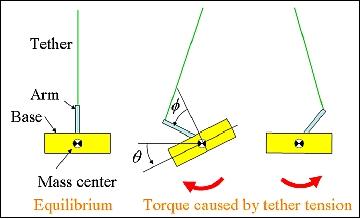The phys.org new item Image: Small satellite deployed from the Space Station shows the cubesat craft Space Tethered Autonomous Robotic Satellite (STARS-C) being deployed from the ISS.
A satellite is ejected from the Japan Aerospace Exploration Agency (JAXA) Small Satellite Orbital Deployer on the International Space Station on Dec. 19, 2016. The satellite is actually two small satellites that, once at a safe distance from the station, separated from each other, but were still connected by a 100-meter-long Kevlar tether.
This is the third in a series of STARS tethered cubesat missions, and the 100 meter tether is a significant step beyond the 10 meter tether of STARS-2 for example.
There are a number of scientific and technical issues to be addressed by this series of missions, my question is only about the tether tensions method of attitude control of the 'daughter satellite'.
above: "Figure 8: Attitude control model of the daughter sub-satellite by the arm link technique (image credit: Kagawa University)" from here.
I am wondering about the dynamics of this system during an attitude change. If I understand correctly, the daughter sub-satellite holds the tether line with an articulated "arm", and changing the orientation of the arm (articulating the arm's "shoulder") will change the sub-satellite's attitude with respect to the tether direction, and therefore the nadir.
Would a significant attitude change (say 30 degrees) made this way tend to set up oscillations requiring damping? Could it be used to point a small telescope or directional antenna to track one point on the Earth (about 1.1 degrees/sec at 400km) for say 30 seconds, then slew to the next point within 5 or 10 seconds, then track that point, or would the whole thing just start oscillating in some way, requiring some kind of damping mechanism?
I don't mean perfect ground tracking, just something to get rid of most of the approximately 7 km/sec apparent ground motion of the earth seen through a telephoto lens camera or small telescope so that reasonable shutter speeds (or frame capture rates) can be used with modest f/no.
